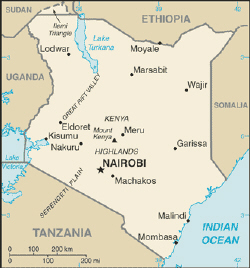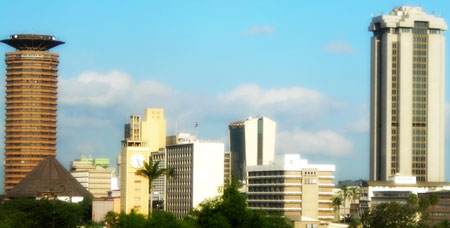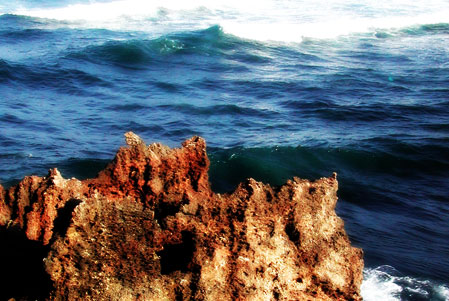

Market of the Month –Kenya
Kenya is the most developed economy in Eastern Africa. With a nominal 2007 gross domestic product (GDP) of US$29.3 billion, it is also the economic, commercial and logistical hub of the entire region. Kenya’s estimated population is 37,953,838.
The country features an extensive infrastructure, a strong entrepreneurial tradition, and a population that is extraordinarily well educated, English-speaking and multi-lingual. It is also a very young country, with nearly 50 percent of the population under the age of 15. An estimated 46 percent of Kenyans live below the poverty line and the country's GDP per capita is about US$478.
Kenya's strengths include its human resources, natural assets and strategic location. The economy registered highly respectable growth rates of 4.9 percent, 5.8 percent and 6.1 percent in 2004, 2005 and 2006 respectively. In 2007, the economy is believed to have grown at 7 percent. The government has taken steps to enhance Kenya’s economic competitiveness, and democracy is flourishing.
Nairobi, the capital of Kenya, is the undisputed transportation hub of Eastern and Central Africa, as well as the largest city between Cairo and Johannesburg. The Port of Mombasa is the most important deep water port in the region, supplying the shipping needs of more than a dozen countries, despite stubborn deficiencies in equipment, inefficiency and petty corruption.
Kenya's financial and manufacturing industries, while relatively modest, are the most sophisticated in Eastern Africa. The country’s tourism industry, already one of the most successful in the world, continues to expand. While Kenya’s mineral resources are limited, the nation is attractive as a potentially important source of valuable materials, such as titanium. At present, significant sums also are being invested in the search for oil off the Indian Ocean coast.
The agricultural sector is the largest employer in Kenya. The country’s major exports are tea, coffee, cut flowers and vegetables. Tea exports, traditionally Kenya’s largest single foreign exchange earner, fell to third place behind tourism and horticulture in both 2005 and 2006. Tea exports in 2006 netted the country US$656.7 million, up 17 percent from 2005. Horticulture earned the country US$677 million in 2006, an increase of 15 percent over 2005.
Tourism, grossing US$803 million in 2006, is now Kenya’s largest foreign exchange earner. Tourist arrivals in the first nine months of 2007 increased by 13.3 percent from the same period the previous year and generated 22.4 percent of Kenya’s earnings in 2006. Growth was due in part to better marketing in key European, U.S. and Asian markets. While Europe remains the largest and most important source of tourists for Kenya, U.S. tourist arrivals in 2006 were up 21 percent in the first nine months of 2007.
Kenya’s volume of trade increased by 9.8 percent from 2005 to 2006. Significant increases in exports were recorded in iron and steel products, cement, horticulture, tea, coffee, and articles of apparel and clothing accessories, which together accounted for almost 60 percent of total export earnings in 2006. Export earnings increased to US$3.48 billion from January to July 2007.
While exports grew by more than a third in 2006, Kenya’s import bill grew by 27 percent. With export growth outpacing that of imports, merchandise trade deficits have trended downward year on year. The total import bill for Kenya in 2006 was US$7.2 billion. The increase in value of merchandise imports was largely reflected in machinery and transport equipment, manufactured goods, chemicals, and petroleum products.
U.S exports to Kenya fell 17.5 percent, but that figure is deceiving. Although aircraft exports fell by $214 million (50 percent lower than the previous year), growth in the other top 10 export categories came close to compensating. African Growth and Opportunity Act (AGOA) garments represent more than 70 percent of Kenyan exports to the U.S., although the share falls each year.

Map of Kenya
 | Telecommunications Equipment |
 | Agricultural Machinery and Equipment |
 | Computers and Peripherals |
 | Construction Equipment |
 | Aircraft and Aircraft Parts |
 | Agricultural Chemicals |
 | Educational Services |
 | Medical Equipment |
 | Cosmetics |
 | Electrical Power Systems |
 | Agricultural Sector |
See a description of Kenya’s Best Prospects
The best way for U.S. manufacturers and suppliers to penetrate the Kenyan market is to start by accessing the network of services and programs available through the U.S. Department of Commerce, U.S. Commercial Service and U.S. Export Assistance Centers (USEACs). Visit the BuyUSA site for more information.
Next, businesses can gain extensive knowledge, industry contacts and services from the U.S. Commercial Service East Africa at the Nairobi Embassy in the U.S. Embassy. Visit the BuyUSA East Africa site for more information. Seeking the assistance of a USEAC before exploring an opportunity in this market is encouraged.
While there is solid potential for U.S. goods and services in Kenya, the country is a developing nation with a complex market. The U.S. exporter should keep certain factors in mind to achieve maximum success, with logistics and safety key among these.
Given excellent business and political relations between Kenya and the U.S., there are significant commercial opportunities for U.S. firms. The principles of customary business courtesy, especially replying promptly to requests for price quotations and orders, are a prerequisite for exporting success. In general, Kenyan business executives are sophisticated, informal and open. The use of first names at an early stage of a business relationship is acceptable. Friendship and mutual trust are highly valued, and once an American has earned this trust, a productive working relationship can usually be obtained.
Thanks in part to a growing prevalence of overseas Kenyans doing business with and often returning to Kenya to live and work. Kenyan firms have significant expertise in international business. Kenyan buyers appreciate quality and service, and, if justified, are willing to pay a premium if they are convinced of a product's overall superiority. The market, however, remains very price sensitive. Care must be taken to ensure that delivery dates are closely adhered to and that after-sales service is promptly honored. As there are numerous factors that may interfere with prompt shipment, U.S. exporters should allow for additional shipping time to Kenya and ensure the Kenyan buyer is continuously updated on changes in shipping schedules and routing. Since Kenyan wholesalers and retailers generally do a lower volume of business than their American counterparts, U.S. firms should be prepared to sell smaller quantities than is normal in the U.S.
U.S. firms should maintain close contact with distributors and customers to exchange information and ideas. Local distributors/representatives can serve as an excellent source of local market information and as appraisers of product market acceptance. In most instances, mail, fax or telephone communications are sufficient, but the understanding developed through periodic personal visits is the best way to keep distributors apprised of new developments or to resolve problems quickly. Prompt acknowledgment of correspondence by fax or email is mandatory.

Kenyatta Center in Nirobi
If the market size warrants, U.S. marketers should seriously consider warehousing in Kenya for speedy supply and service to customers. Local assembly of complete knock down kits, especially for electrical and electronic goods, is recommended. This has proven viable in the Kenyan market and also has an import duty advantage.
Products must be adapted to both technical requirements and to consumer preferences, as well as to meet government regulations. The Kenyan government is keen to ensure that all imports conform to the stipulated technical specifications; any flaws detected could result in the withdrawal of the product from the market, prosecution of the manufacturer and the retailer/importer, or both.
It is not sufficient to merely label a product in conformity with national requirements to achieve successful market penetration. Consumers must be attracted to the product by the label and packaging, as well as ease of use.
The U.S. maintains a travel warning on Kenya due to the threat of terrorism and violent crime. For information on the travel warning, visit the Department of State’s Travel Warning site.
 | Location: Eastern Africa, bordering the Indian Ocean, between Somalia and Tanzania |
 | Area: Total: 528,650 sq km; Land: 562,950 sq km; Water: 13,400 sq km |
 | Climate: Varies from tropical along coast to arid in interior |
 | Population: 37,953,838 (July 2008 est.) |
 | Languages: English (official), Kiswahili (official), numerous indigenous languages |
 | Government Type: Republic |
 | GDP (purchasing power parity): $58.88 billion (2007 est.) |
 | GDP Real Growth Rate: 7 percent (2007 est.) |
 | GDP by Sector: Agriculture: 23.8 percent; industry 16.7 percent; 59.5 percent (2007 est.) |
 | Labor Force: 11.85 million (2005 est.) |
 | Principal Exports: Food and beverages, manufactured goods, petroleum products, chemicals, textiles |
 | Main Imports: Machinery, transport equipment, fuels, chemicals |
For events information, visit the BuyUSA East Africa site.

Scene from Mombasa, an island on the coast of Kenya
The U.S. Commercial Service offers customized solutions to help your business enter and succeed in markets worldwide. Our global network of trade specialists will work one-on-one with you through every step of the exporting process, helping you to:
 | Target the best markets with our world-class research |
 | Promote your products and services to qualified buyers |
 | Meet the best distributors and agents for your products and services |
 | Overcome potential challenges or trade barriers |
For more information on the services the U.S. Commercial Service offers U.S. businesses, visit the BuyUSA East Africa site.